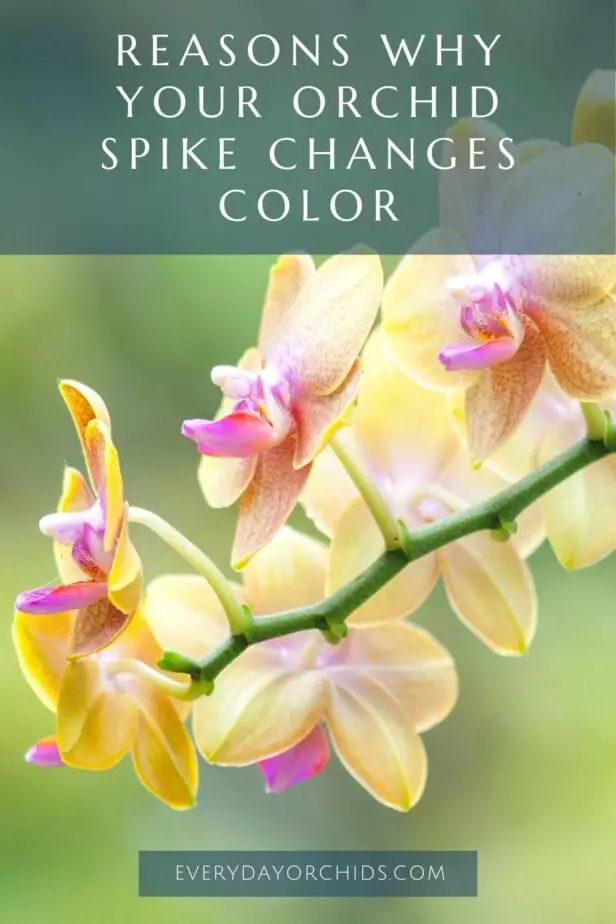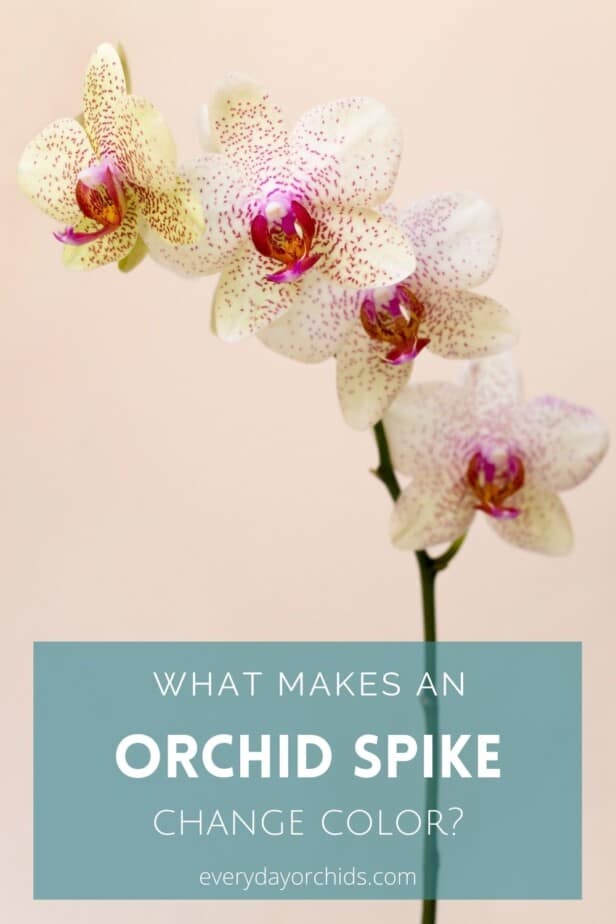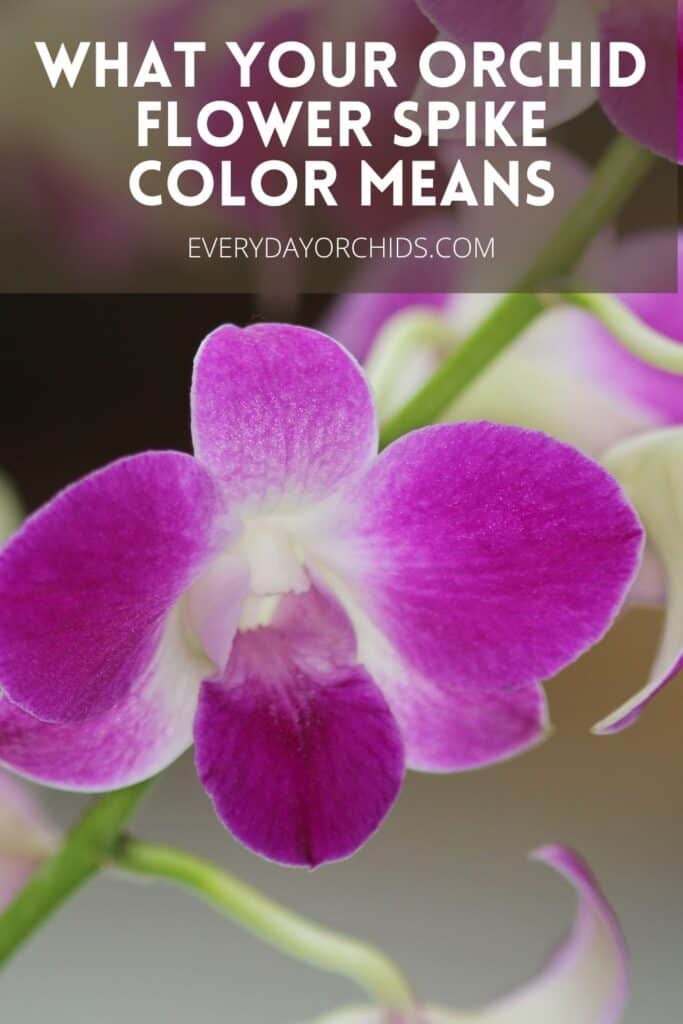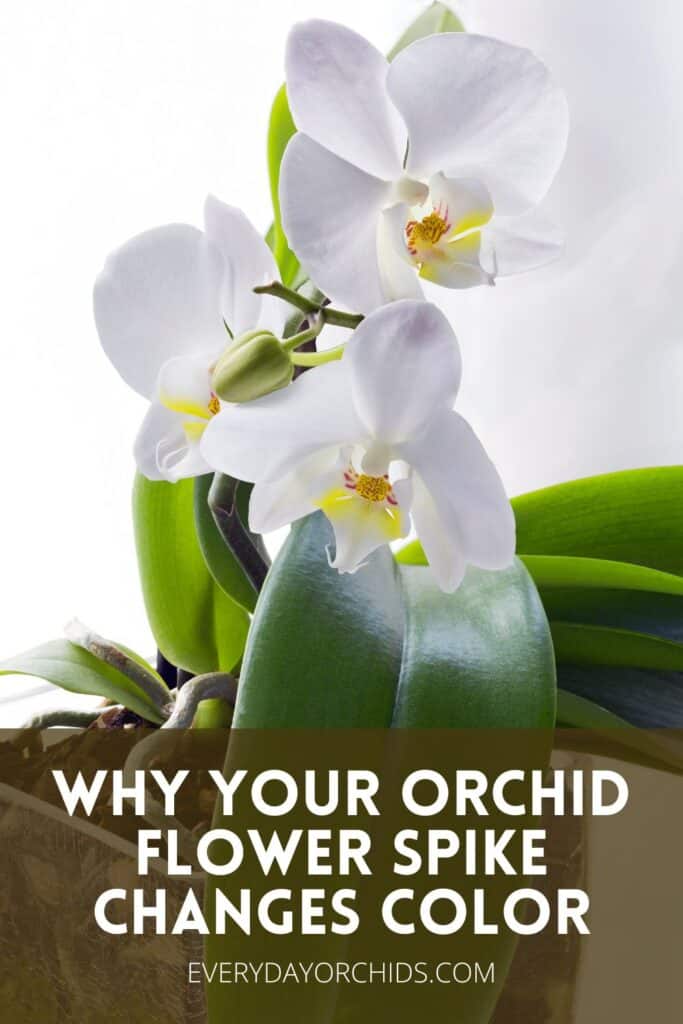An orchid spike, or orchid flower stem, can change color for a number of reasons. Understanding why these color changes happen can help you detect problems with your orchid early on.
When caring for orchids, it is very important to pay attention to every subtle change in color. It is more common for the orchid leaves to change color.
However, there are times when the orchid flower spike, also known as the stem, changes color too. What do these changes mean for you and your orchids?
Orchid flower spikes can turn yellow, red, pink, purple, brown, or black for several reasons. A healthy orchid flower spike, or flower stem, is often green. The orchid’s health, surrounding environment, and how you care for your orchids may lead to a change in flower spike color. Oftentimes, the orchid flower spike will change color late in the blooming cycle, as the flowers fall off and the stem begins to die.
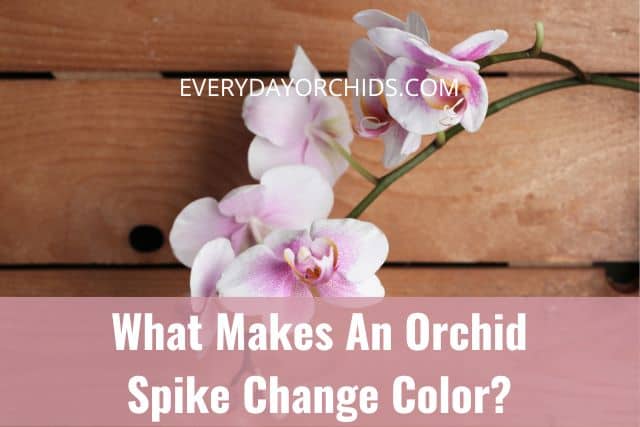
Some of these color changes may be alarming, but in many cases, the color change is normal. Most of the time, color changes in the orchid flower spike are not a cause for concern. I will go over the different color changes you might see in your orchid spike, or orchid stem, and what you may need to do about it.
Note: Orchid spikes are also sometimes referred to as orchid stems, but I will mainly use the term “orchid flower spike,” or “orchid spike” throughout this article. If I happen to use the term “orchid stem,” please know I am talking about the orchid flower stem.
Please note that these links are affiliate links and as an Amazon Associate, I earn from qualifying purchases. Purchases made through affiliate links in this post may generate commissions at no additional cost to you. Use this link for a discounted Amazon Prime trial. Thank you for your support!
Table of Contents
What Color Is a Healthy Orchid Flower Spike?
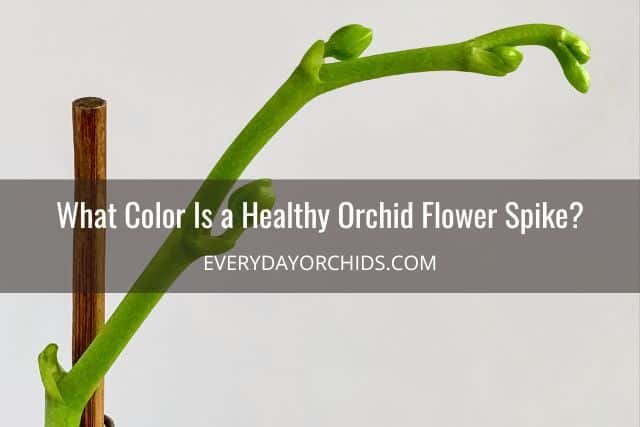
The color of a healthy orchid flower spike is green. You should aim for this color in all of your orchid flower spikes and stems.
A green orchid spike means that the orchid is capable of transporting nutrients from the roots and leaves to the flowers. However, there may be times when the flower spike turns red, pink, purple, yellow, brown, or black.
What is an Orchid Flower Spike?
An orchid flower spike is where buds form and eventually, flowers bloom on an orchid. This flower spike can also be referred to as an inflorescence. Sometimes, people also refer to the orchid spike as the orchid stem.
This is where orchid terminology can sometimes get confusing. For example, an orchid “stem” can refer to the flower spike. However, in monopodial orchids like Phalaenopsis orchids, “orchid stem” could also refer to the main stem of the orchid. The main stem is where the leaves meet at the base of the orchid. In sympodial orchids with pseudobulbs, such as Dendrobiums or Cymbidiums, orchid “stem” can refer to the pseudobulb.
Here, I will be mainly talking about the flower spikes of Phalaenopsis orchids and why you may see these flower spikes turn different colors.
Why Does The Color of an Orchid Flower Spike Matter?
Color changes are an orchid’s way of communicating with you, for better or for worse. You can see this in the leaves. Changes in leaf color can indicate changes in the orchid’s health. It is the same for changes in orchid flower spike color.
Oftentimes, changes in an orchid flower spike’s color are not a cause for alarm. It generally does not mean your orchid is dying. If anything, it might just mean that you have to make some minor adjustments to your care.
For example, some orchid spikes will change color in response to light. Phalaenopsis orchids react to sunlight similarly to humans — we tan or burn, and orchid spikes turn red or pink. It’s the plant’s way of telling you to reduce the amount of light exposure.
A green orchid spike indicates a healthy orchid. Other colors may or may not necessary tell you about your orchid’s health. However, they may tell you that you need to change something in the environment or your care practices.
Let’s talk about the different colors that an orchid flower spike can have and what this may mean in your orchid.
Why Is My Orchid Flower Spike Turning Yellow?
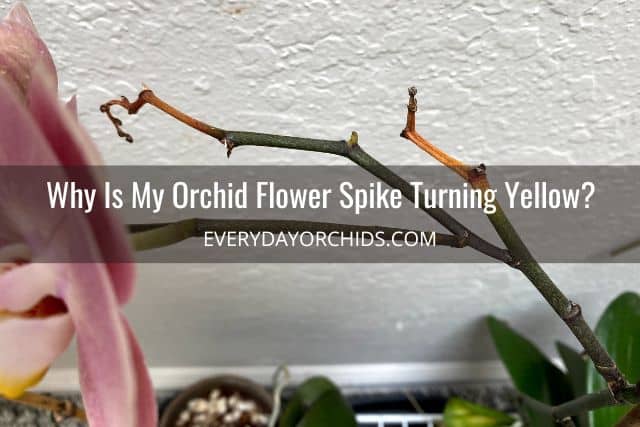
There are a few reasons why your orchid spike, or orchid stem, can turn yellow. Below, I’ll go over some of the top reasons why your orchid stem may be turn yellow.
Blooming is Done
One of the most common reasons why an orchid’s flower spike turns yellow is that the orchid has finished blooming.
As the orchid spike starts to die, it will turn yellow and eventually, brown. This is totally normal and signals the end of the orchid’s blooming cycle.
Once the orchid spike starts to turn yellow, it means that this particular spike is done supporting life. It no longer has the means necessary to produce blooms. In other words, you will not be able to trigger reblooming from a yellow orchid spike.
The best course of action is to cut it off. Prune the orchid spike right below the yellow discoloration. If you can, cut above the node using a sterilized blade. Apply ground cinnamon to the cut end of the orchid spike. Leave any green parts of the spike intact. This may or may not work to stop the rest of the flower spike from turning yellow.
If the remainder of the spike continues to turn yellow, despite your best pruning efforts, then your orchid is signaling to you that this spike is completely done producing flowers. In this case, you might as well cut the spike off closer to the base.
However, if you prune off just the yellow section of the spike and the remainder of the orchid spike stays green, then there is a chance that you can trigger reblooming in your orchid.
Keep watering and fertilizing your orchid as you normally would. In a few weeks, your orchid may grow a new flower spike from a lower node on that original orchid spike.
Over-Fertilization
Another reason why an orchid spike can turn yellow is over-fertilization. Excessive amounts of fertilizer can affect the color of an orchid’s leaves and spike. You may need to re-evaluate the amount of fertilizer you are using, the type of fertilizer, and if you have been diluting it properly.
Orchids need more fertilizer during growth periods and less during their dormant periods. If your orchid is in its dormant stage, it is best to reduce the frequency of fertilizing.
Fertilizing your orchid may be something that you have to adjust or modify incrementally. Observe your orchid after each adjustment to see if that change was what your orchid needed.
Too Much Light
If your orchid spike still continues to turn yellow, the next thing you will want to do is evaluate your orchid’s light exposure. Phalaenopsis orchid flower spikes may turn yellow or light yellow if the orchid is exposed to too much sunlight.
Exposure to too much light may start with a slight yellow discoloration. However, prolonged exposure could lead to sunburn. The easiest way to deal with this problem is to move the orchid to a lower light area. You can also use a curtain to reduce the amount of light your orchid receives.
Why Is My Orchid Flower Spike Turning Brown?

After “yellow,” brown orchid flower spikes are probably most common. Earlier I mentioned that at the end of a blooming cycle, as the orchid flower spike dies, it will turn yellow.
As the yellow discoloration spreads down the orchid spike and the spike starts to dry up, it will turn light brown. If the orchid spike is brown, it usually also looks dry and brittle. A brown orchid spike is a dead flower spike.
It doesn’t mean that your orchid is dead though. If you see an orchid spike turning brown, it only means that the plant is moving through a natural blooming cycle. Your orchid is done blooming on that particular orchid spike.
If you didn’t know this, a brown orchid spike may appear concerning, but don’t worry, it is totally normal.
Where to Prune Your Orchid Spike
You can trim off the brown part of the flower spike, cutting down to just above a node or branch. Alternatively, you can just cut the orchid flower stem all the way down to the base.
Either method can encourage the growth of new flower spikes, but the results may vary depending on your particular orchid.
If you choose to prune your orchid spike to a point just above a branch, you create a possibility that the orchid will produce another flower stem on the side and start another blooming cycle.
Keep in mind that if this happens, it will be a much faster cycle. The flowers will be smaller and will not last as long. This is due to the fact that the orchid did not get a chance to go through the full growth phase. The orchid did not have the opportunity to store energy for the new blooming period. Instead, it is jumping right into the next blooming cycle.
Pruning the orchid spike down to the base will result in the orchid taking longer to produce another flower spike. Essentially, the orchid will be starting “from scratch.” However, these blooms will be more similar in size to the previous blooms you saw on your orchid. This is because the orchid will have had time to store up energy for the orchid blooms.
Why Is My Orchid Spike Turning Black?

Seeing a black spike on an orchid can be scary. Sometimes this can happen due to disease or problems with your orchid’s health. Below, I will go over some reasons why your orchid’s flower spike may be turning black.
Low Humidity Levels
If the black discoloration is just confined to the orchid spike and doesn’t affect the leaves, roots or main orchid stem (where the leaves join the base of the orchid), then breathe a sigh of relief and check your humidity levels.
You’ll need a hygrometer for this. A hygrometer is a relatively inexpensive tool you can use to measure humidity (and usually temperature) levels in your orchid’s growing area. Proper humidity levels are so important for orchid health.
Black discolored spikes may be an indicator of low humidity. To fix this, try increasing the surrounding humidity. If the potting media feels dry and the orchid pot is light, you will need to water your orchid.
You can also set up a humidity tray under your orchid pots. As the water in the tray evaporates, it will add some humidity around the orchid plant.
If you’d rather not use a humidity tray, you can use a humidifier instead. This is what I do since I have so many orchids. It just makes more sense to humidify the whole area.
For some other ideas, here are other easy ways you can increase humidity for your orchids.
While you are adjusting the humidity levels around the orchid, be sure to also maintain light exposure. Allow your orchid to continue to receive lots of bright, indirect light.
If the black discoloration is due to dryness and low humidity, with these changes, you can expect the black discoloration to minimize in a few weeks.
Blooming is Done
Phalaenopsis orchid flower spikes may also turn black after blooming, as the spike starts to die.
The best way to deal with this is to take sterilized scissors or gardening shears and prune off the orchid spike. Cut below the blackened area and dust the cut end of the remaining orchid spike with ground cinnamon powder. This will help seal off the spike and prevent infection.
Pruning off this blackened area will also allow your orchid to grow new flower spikes from a lower node, if there are any. You can also prune the blackened spike all the way down to the base if you prefer.
Rot or Disease
A more alarming reason why orchid spikes turn black is rot or a fungal infection. If you have been doing everything else right and your orchid has not bloomed yet, then a black orchid spike can indicate disease.
In this case, you want to isolate your orchid from your other plants. Inspect it thoroughly and check for any other abnormalities or blackened areas on your orchid. Look for pests.
If the blackened area is isolated to the orchid flower spike, but progressing down the spike, then you will need to do some pruning.
Take some sterilized scissors or gardening shears and cut your orchid spike below the blackened area. Dust the cut end with ground cinnamon powder.
If the blackened area continues to spread down the spike, then cut again below the blackened area and dust with cinnamon powder.
Another reason why orchid flower spikes, stems, and leaves can turn black is crown rot.
Crown rot is a fairly common problem for beginner orchid growers. Water settles into the orchid crown due to improper watering techniques. Fungus grows in this standing water and infects the plant. Over time, the fungal infection will cause the main orchid stem to rot and turn black and die.
You will have many warning signs before it gets to this point though. For one, the leaves will start to turn yellow and fall off, one by one. Once you see this starting to happen, take action to treat the crown rot and try to save your plant from dying.
This is partly why it is so important to regularly inspect your orchids. It also underscores the importance of understanding what different color changes in the leaves and stems mean.
Why Is My Orchid Flower Spike Turning Red?
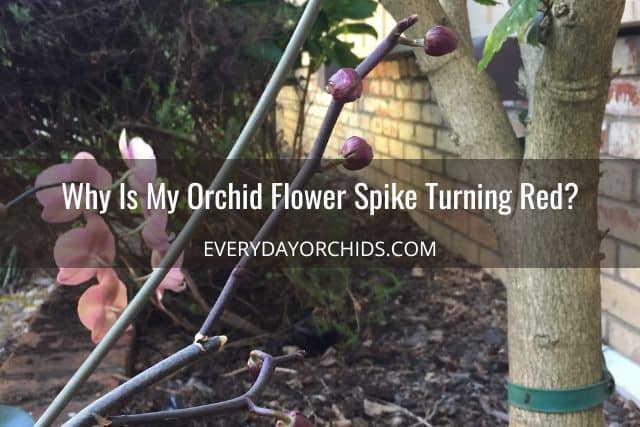
There are a few reasons why your orchid spike may appear red. I’ll talk about these below.
Too Much Light Exposure
Sometimes, the flower spikes of Phalaenopsis orchids can turn red or reddish due to environmental factors.
One cause of this is too much light exposure. This is a normal reaction that these plants may have with their environment. Think of it like how we might get sunburned if we are outside all day and got too much sun.
Keep in mind that the reasons why orchid flower spikes and orchid flower stems change color can vary based on the orchid species and the situation. Cattleya orchid flower stems, for example, will take on a red color if the orchid has had enough sunlight.
Red orchid spikes are easy to spot in Phalaenopsis orchids. If excessive light exposure is the problem, you can address this by relocating the orchid to a lower light area.
Alternatively, you can use a thin or sheer curtain to reduce or filter out excess sunlight. It may take a few weeks before the reddish tone disappears completely.
However, there are times when you might not want to relocate your plant or make this change. As long as the orchid leaves are not turning yellow (a sure sign of too much light), you can leave your orchid where it is. Some orchid plants produce better flowers if the plant gets a lot of sunlight.
Genetics
In some cases, the genetics of your particular orchid species will result in a red, not green, orchid spike. If this happens, it is totally normal!
In fact, one of my orchids right now has a red flower spike. This particular orchid has always had red flower spikes. It has appeared healthy through the years, blooming at least once or twice a year. This orchid is housed with several other orchids, all of whom have green stems. All the orchids are exposed to the same amounts of light, water, temperature and humidity.
This leads me to believe that genetics is the cause of this orchid’s red-colored spike, not environmental factors. All this to say that red orchid spikes are not always a sign of a problem and can be perfectly normal.
If your orchid appears healthy, is growing and continuing to bloom, and just happens to have a red-colored orchid flower spike, then don’t worry about it and enjoy the blooms.
Why Is My Orchid Flower Spike Turning Pink?
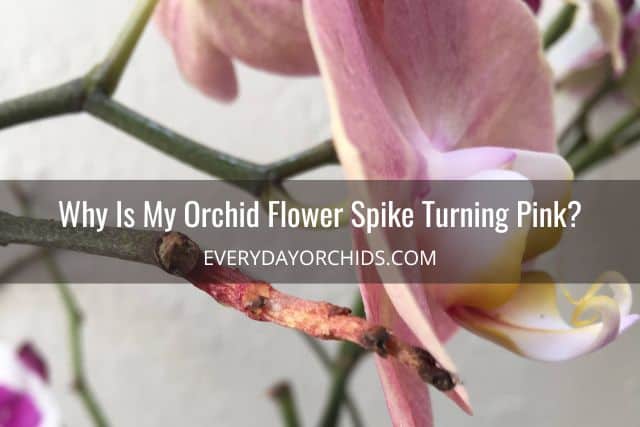
Your orchid flower spike might have turned pink for a couple of reasons. One, the blooming cycle is over and the pink spike is signaling the end of the blooming season. Two, the orchid may be dehydrated and the pink spike is indicating that your orchid needs more water.
The End of a Blooming Cycle
When an orchid goes through a blooming cycle, some parts of the orchid spike may remain green. These green areas have a chance to produce another flower spike from any one of the remaining nodes.
Other parts of the orchid flower spike will turn pink, yellow, brown, or black and die off. This is completely normal.
Pink is one of the colors that the orchid flower spike might exhibit as it dies off.
In a pink orchid flower spike, nutrients and water are no longer being transported along this orchid spike. When you notice this change in color, you can simply prune your orchid spike back to a spot just above a node.
If the pink discoloration is widespread and travels down the orchid spike, you can also prune the spike back all the way down to the base. In either situation, be sure you use sterilized scissors or gardening shears to cut your orchid spike, and dust the cut end with ground cinnamon powder.
Dehydration and Not Enough Water
If your orchid has not bloomed yet, it is possible that the pink tinge in the orchid spike is due to dehydration rather than the spike dying.
You may also notice that your orchid leaves are wrinkled, wilted or limp. Either you’re not giving your orchid enough water or the orchid is unable to absorb the water. The latter can be a result of root rot or dried, shriveled roots.
In both of these situations, the roots can no longer absorb water. You will need to unpot the orchid, trim off any rotted or dead roots and inspect the orchid roots’ health. If you aren’t sure if your orchid has root rot, check out this Everyday Orchids article that details how to spot root rot in orchids.
Repotting or changing the watering frequency are easy enough fixes. Moving forward though, you will need to be more mindful of regularly inspecting your orchid leaves and roots. Keep a regular watering schedule and check the potting media to make sure you are on track.
Why Is My Orchid Flower Spike Turning Purple?
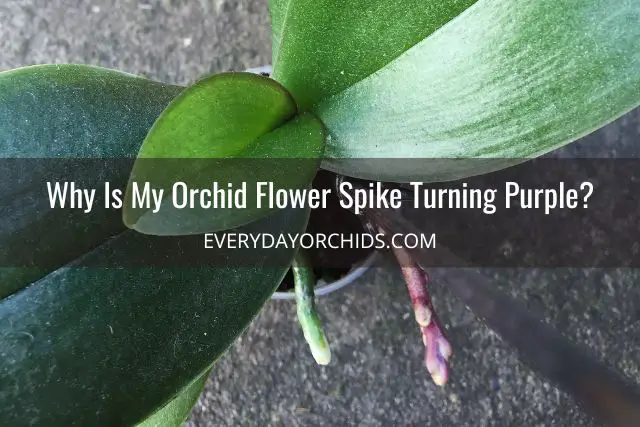
In many cases, purple discoloration is usually seen in the leaves, and on the underside of the leaves at that. However, there are some cases where the orchid flower spike turns purple or takes on a purplish tone.
This is normal for many orchids, especially low light orchids such as the Phalaenopsis orchid. Like most discolorations or color changes that you will see, this is due to excessive light exposure.
Too Much Light Exposure
Yellow and pink tinged orchid spikes are typical signs that an orchid is receiving too much light. However, these colors may progress to red or purple tones. If this happens, it means that the orchid is nearing its tolerance level for light exposure.
Your orchid can communicate with you in so many ways. If you are trying to figure out if your orchid is getting adequate amounts of light, leaf color and flower spike colors are great indicators of this.
If the orchid flower spike is starting to take on purple tones, then you will need to reduce the light exposure. The easiest thing to do would be to move your orchid further away from the source of light.
The End of a Blooming Cycle
Another reason why an orchid spike may turn purple is that it is finishing a blooming cycle. This is something that is normal for many orchids. However, you may still need to observe it to see whether you should remove it from the plant or not.
Why Is My Orchid Flower Spike Changing Color After Pruning?
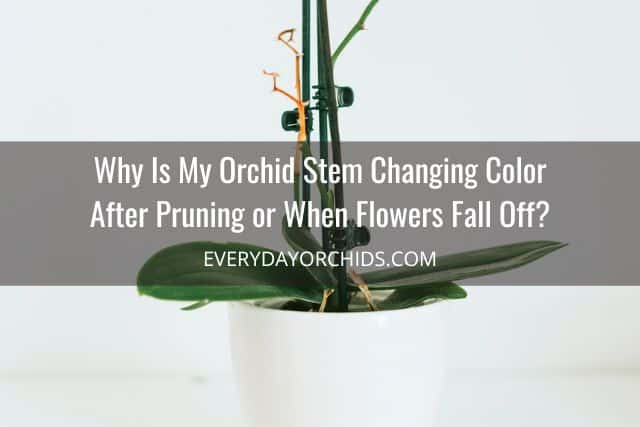
What if your orchid spike changes color after you have pruned it or the flowers have fallen off? I talked about earlier how an orchid stem may turn yellow, pink, or brown, or even black after a blooming cycle has ended.
The end of the blooming cycle generally coincides with the flowers wilting and falling off. In a typical orchid growth and blooming cycle, the orchid undergoes these steps:
- The orchid plant grows new roots and leaves.
- Energy is directed at blooming and growth of a new flower spike.
- Any old spikes remaining on the plant will not receive energy for bloom production. Instead, the plant will focus all of its energy on the newer spike and produce a new flower spike.
- The old orchid flower spike, with its lack of nutrients and energy, will slowly die off.
Now, this process will be the same regardless of the orchid species that you are caring for. Some species will enter a “dormancy” stage where the plant tries to conserve energy to make the new flower spike.
Of course, some orchid flower spikes will stay green and retain their possibility of growing new spikes. I have these in a few of my Phalaenopsis orchids. I just leave these green spikes alone and do not try to prune them. In my experience, these green spikes have been able to produce more spikes from a lower node.
Final Thoughts
Changes in orchid spikes color are usually normal. Remember, there are three main reasons why orchid flower spikes can change color: health or end of a blooming cycle, environmental conditions, and how you care for your orchids.
In many cases, you shouldn’t be alarmed by these discolorations. For the most part, color changes in the orchid spike can be handled with pruning or minor changes in care.
The only exception would be when the orchid flower spike turns black.
This can be a result of disease or rot. In this case, you will need to cut off the flower spike and do a little more investigating into why it turned black in the first place.
If you want to keep your orchid healthy, you have to consider all of these things to figure out the best course of action that you should take. Sometimes, it will be a process of elimination before you correctly figure out what is wrong with your orchid. Hope this helps! As always, happy orchid growing!
If you enjoyed this article, please pin it and share!

